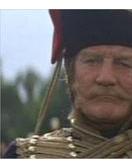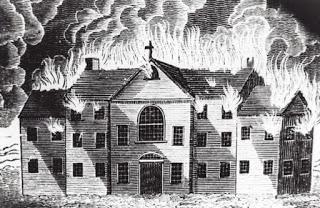 Anti-Catholic sentiment came deeply engrained in the American psyche. Primarily English and overwhelmingly Protestant, America's earliest settlers carried racial memories of Henry VIII's Reformation, Mary Tudor's bloody reaction, Elizabeth I's battle against Catholics at home, abroad and across the Scottish border, the Stuart restoration and Glorious Revolution. France and Spain remained England's perennial enemies, menacing England, its empire and its colonies.
Anti-Catholic sentiment came deeply engrained in the American psyche. Primarily English and overwhelmingly Protestant, America's earliest settlers carried racial memories of Henry VIII's Reformation, Mary Tudor's bloody reaction, Elizabeth I's battle against Catholics at home, abroad and across the Scottish border, the Stuart restoration and Glorious Revolution. France and Spain remained England's perennial enemies, menacing England, its empire and its colonies. Thus the early colonies proclaimed themselves a Protestant bastion, restricting the rights and franchise of Catholics. North Carolina's earliest constitution promised "Full liberty of conscience to all, exempting Papists." New York passed laws in the 1690s disarming Catholic colonists and forbidding priests from entering the colony. New Hampshire required all office holders to take an oath renouncing Rome. Even Maryland, initially established as a Catholic haven, witnessed a backlash that restricted Catholics to Baltimore and coastal enclaves.
Even the Founding Fathers shared these prejudices: John Adams attacked the "fraud, bigotry, impudence and superstition, on which the Papal Usurpations are founded." Nonetheless, the Revolution dampened such sentiments, Catholics and Protestants alike joining against the British (an alliance made easier by France's support for independence). The First Amendment, prohibiting a state religion, and the outlawing of "religious tests" for office, repudiated institutional bigotry.

Racial memory: Archbishop Thomas Cranmer's execution, 1556
George Washington emphasized his support for religious minorities. He established friendly ties with American Jews and even the small Muslim community in Charleston, South Carolina. He also reached out to Catholics, reminding Americans to "not forget the patriotic part which you took in the accomplishment of their Revolution, and the Establishment of their government." Over the succeeding decades, anti-Catholic sentiment receded from public life.Yet congenital prejudice never fully disappears, and by the 1820s it started bubbling to the surface. The Second Great Awakening of 1819 played its role, converting millions of Americans to fierce Calvinist evangelism. England's debates over Catholic emancipation led to an outpouring of anti-Catholic literature that spread overseas. With it came waves of Irish and German immigrants, who became fodder for menial jobs, mired in poverty or ensnared in crime.
The first wave of anti-Catholicism targeted not immigrants, but the Church itself. While reasonable critics attacked the Church's real inequities and corruption, from meddling in temporal politics to the selling of indulgences, more base or deluded critics characterized Catholics as Machiavellian monsters. They hallucinated a massive plot directed from Rome to corrupt and destroy American society from within. Thus conspiracy theories replaced reason in politics, with tragic and lasting results.
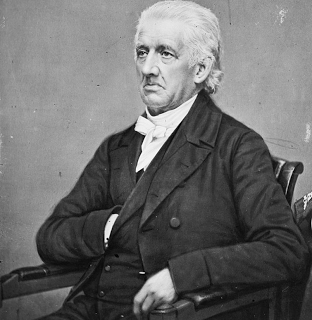
Lyman Beecher, Calvinist Apostle of Hate
Lyman Beecher led the hatemongers. A Presbyterian based in Boston, he inveighed against alcohol, Unitarianism and, most fervently, Catholicism. He called the Church the "whoredom of Babylon" and savaged its iniquities in language befitting a gothic novel. The Church, Beecher thundered, "is the most skillful, powerful, dreadful system of corruption to those who wield it and of debasement and slavery to those who live under it, who ever spread darkness and desolation upon the Earth."Beecher's message, expressed through pulpit-pounding sermons and his book A Plea for the West, found a ready audience. Publications entitled The American Protestant Vindicator and The Downfall of Babylon invented papal plots, Catholic crimes and debauchery. The Vindicator warned that "Jesuits are prowling about all parts of the United States in every possible disguise to disseminate popery," fingering music teachers and "puppet showmen" as undercover priests. Samuel F. Morse, artist and inventor, warned that "Austria is now acting in this country," flooding America with immigrants and installing a Hapsburg emperor.
Catholics often didn't help their own case. Irish and German immigrants braced themselves against hostile natives by forming nationalist societies (ranging from social clubs to political organizations). Rougher characters joined street gangs in Boston and New York for protection against crime, police and native bigots. And Reverend John J. Hughes, Archbishop of New York, inmprudently proclaimed "our mission to convert the world—including the inhabitants of the United States" to Catholicism.
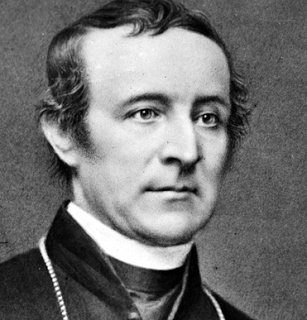
John J. Hughes, Intemperate Defender of the Faith
What captured the public imagination was the Catholic convent. These all-female communities where nuns worshipped in solitude fired the imaginations of Protestant voyeurs. Richard Hofstader observed that "Anti-Catholicism has always been the pornography of the Puritan," and the Nativist mind recast them as houses of depravity, where priests impregnated nuns, nuns tortured or even murdered children... and occasionally, enslaved virtuous Protestant girls.Such was Rebecca Reed's claim. A young woman from Boston, she had entered the Ursuline Convent in nearby Charlestown as a charity scholar in 1831. Established in 1826 on Mt. Benedict, this convent taught not only Catholic girls, but Bostonian Protestants (mostly wealthy Unitarians annoyed with public schools' Congregationalist cast) as well. One such girl, Lucy Thaxter, recalled that "I never found it other than a happy home, nor ever experienced any other treatment than...kindness and sympathy."
Reed found her experience less endearing. She briefly became a novice herself, but left after several months of study. Her Mother Superior, Mother St. George (nee Mary Ann Moffat), cited her "flighty and unsteady disposition of mind." Mother St. George, daughter of a British soldier, did not suffer fools. Her detractors branded her a "brass figurehead," and she once boasted "It would be a difficult matter for any man to control me." Reed left the Ursulines in 1833, disillusioned, angry and eager for revenge.
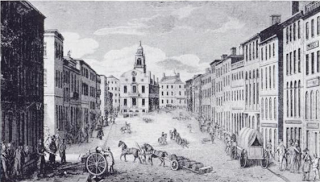
Boston's State Street, ca. 1830
The following year, encouraged by local Protestants, Reed began spreading a dread story. The convent wasn't a school but a prison, which indoctrinated its Protestant pupils into a life of nunnery. She shared lurid tales of underground torture chambers, secret oaths and even live burial. In her telling, she left "to become a humble instrument of the hands of God in warning others of the errors of Romanism, and preventing even one from falling into its snares."While many dismissed Reed as a crank, her story gained currency in evangelical circles and spread to the public. Their preexisting suspicions about the Convent dovetailed with extant tension: in 1833, several drunken Irishmen murdered a Bostonian, leading a Nativist mob to attack Catholic neighborhoods. Bostonians also resented the rich Unitarians who'd rather consort with foreign Catholics than native Protestants. Soon placards appeared threatening violence to the school and to the city's Catholics.
Bishop Benedict J. Fenwick worked with Protestant leaders to ease tensions. Editor of The Pilot, America's oldest Catholic periodical, Fenwick was a modest but tough-minded man eager to defend his flock. He took pride in the Ursuline Convent, deeming it "one of the most splendid institutions of its kind in the United States." He persuaded Charlestown leader Richard S. Fay to inspect the school; Fay remarked that "No attempt was made to impress the minds of [students]" with Catholicism.
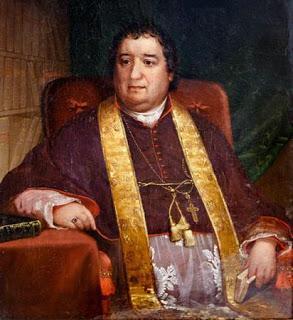
Bishop Benedict J. Fenwick
There the story might have ended, but for a queer coincidence. On July 28th, 1834, Sister Mary John (Elizabeth Harrison), a music teacher, disappeared from the convent. She appeared in the home of Edward Cutter. Scantily clad and mumbling incoherently, she seemed traumatized. A few days later she returned to the convent, blaming her actions on overwork and stress. Cutter visited the Sister at the Convent and left assured that she'd returned of her own free will."Mysterious!" the Boston Mercantile screamed. "A great excitement at present exists in Charlestown, in consequence of the mysterious disappearance of a young lady at the nunnery at that place." The press tied the story in with Rebecca Reed's ravings, claiming that she'd been kidnapped by priests, that she'd been entombed underneath the Convent, victim of priestly perversion. The Mother Superior's refusal to allow an inspection on Saturday, August 9th increased tension. Lyman Beecher poured fuel on the fire the next day, savaging the Ursulines from his pulpit.
Monday, August 11th dawned; Allison Whitney, a student at the Convent, compared the atmosphere to "an unexpected holiday." Mother St. George finally allowed a group of Charlestown selectmen to inspect the school. Despite being heckled by curious students, they prepared a statement urging calm, insisting that "there exists no cause of complaint on the part of" Sister Mary John, or the schoolgirls themselves. Nor did they find any evidence of the torture chambers or passageways Reed described. The selectmen planned to publish this report the following day, but events overtook them.
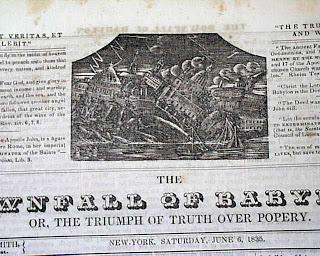
The Downfall of Babylon
That evening, at around 8:00 pm, fifty Protestants marched on the Convent, determined to rescue Sister Mary John. Carrying torches, clubs and banners, shouting "Down with the Pope!" these would-be rescuers marched on the Convent. Mother St. George confronted them, refusing entrance and threatening that Bishop Fenwick "has 20,000 Irishmen at his command in Boston." This only enraged the Mob, who fired pistol shots in the air, then began burning the convent fence.Fire bells rang throughout Charlestown, and within minutes a mob nearing 2,000 men and women closed in on the church. Efforts by the nuns and community leaders, including Thomas Hooper, to stem the violence failed. Hooper told the crowd that "the story about the lady was false" and pleaded for the safety of students and women therein. Someone shouted back "no females should be hurt, but the cross must come down."
So it did. While Mother St. George and the other nuns rushed to save their charges, the Protestants ransacked the convent. They destroyed musical instruments, burned and smashed furniture and valuables, desecrated holy items. One especially vulgar rioter pocketed sacramental wafers, cackling that "I have God's body in my pocket!" Drunken looters stole a silver Eucharist cup and dressed in student's clothes and nun's habits.
Other rioters broke into the library, holding a mock auction for the right to burn its books. Still more burst into the mausoleum, apparently hoping to rescue entombed Protestant women. To their disappointment, they found only six deceased nuns. Sufficed with rage, hatred and liquor, they busted open the nuns' coffins, smashed them with clubs and pocketed teeth and bones as souvenirs.
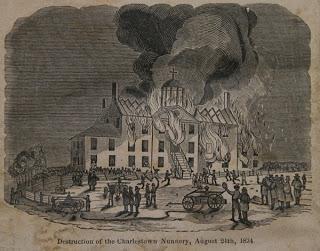
Boston and Charlestown's learned classes reacted in horror. Mayor Theodore Lyman, Jr. convened a meeting at Faneuil Hall the next day, denouncing the riot as "a base and cowardly act." Even Lyman Beecher found the riot disgusting, denouncing it from his pulpits. Yet violence raged on; another mob revisited the convent and completed its destruction on the 12th; others menaced a church on Franklin Street, deterred only by armed militia. Scattered disturbances continued through the 14th, with Protestants burning Catholic homes and lodgings in Boston and Charlestown.
Official denunciation and public outcry availed little. Thirteen members of the mob were tried; only one was convicted, and he was pardoned shortly afterwards. Despite the best efforts of James T. Austin, Massachusetts' Attorney General, it proved a kangaroo court; the Judge discredited Catholic witnesses while encouraging spectators to heckle the prosecution. The Nuns themselves relocated to Quebec, Canada; their convent was never rebuilt.
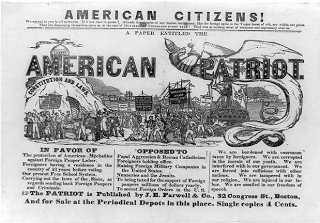
The American Patriot, another anti-Catholic paper
Even this victory didn't satisfy Boston reactionaries. Lyman Beecher wondered "that the capital of New England has been thrown into consternation by the threats of a Catholic mob... dependent on the Catholic powers of Europe and the bayonets of Austria?" Others claimed that the Ursulines destroyed their own convent to gain sympathy. As Massachusetts officials debated reparations for the riot, a newspaper damned "Any man who... would rob the treasury of the descendants of the Puritans to build the Ursuline convent" as "a raving lunatic."Rebecca Reed enjoyed her notoriety, publishing her reminiscences as Six Months in a Covent the following year. The book proved a colossal best-seller, selling 200,000 copies, enjoying several reprints and inspiring a slew of convent exposes, including the notorious Awful Disclosures of Maria Monk, labeled "the Know-Nothing Uncle Tom's Cabin." Reed died in 1838 of tuberculosis; unsurprisingly, Nativists blamed her death on Catholics, claiming she contracted tuberculosis while studying at the Charlestown Convent.
Bishop Fenwick, who restrained angry Catholics from retaliating in the riot's aftermath, complained that "No law or justice is to be expected in this land where Catholics are constantly calumniated and the strongest prejudices exist against them." Indeed, Charlestown merely provided the curtain raiser for America's own Thirty Years' War, a ruthless, sometimes organized, often instinctive campaign to extirpate Catholicism. Not for the last time in American history, specious rumors, absurd speculations and irrational hatreds sparked violence.
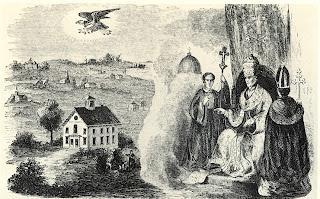
Books: Carleton Beales, Brass-Knuckle Crusade: The Great Know-Nothing Conspiracy, 1820-1860 (1960); David Harry Bennett, The Party of Fear: From Nativist Movements to the New Right in American History (1988); Ray A. Billington, The Protestant Crusade, 1800-1860: A Study of the Origins of American Nativism (1938); Jenny Franchot, Roads to Rome: The Antebellum Protestant Encounter With Catholicism (1994); Gustavus Myers, History of Bigotry in the United States (1960); Nancy Schultz, Fire and Roses: The Burning of the Charlestown Convent, 1834 (2000).
Articles: Jeanne Hamilton, "The Nunnery as Menace: The Burning of the Charlestown Convent, 1834" (Catholic Historian, Winter 1996); Richard A. Hofstader, "The Paranoid Style in American Politics" (Harpers Weekly, November 1964); Carmine A. Prioli, "The Ursuline Outrage" (American Heritage, February-March 1982).
Other articles on American history:
- Eugene McCarthy Versus the Democratic Party, 1968
- George Wallace Stands Up For America, 1968
- Henry Clay Keeps America in Suspense, 1824
- Nelson Rockefeller and the Demise of the Liberal Republican
- Richard Nixon's Deplorables
- Spiro Agnew Grooves On
- William Scranton for President, 1964
- William Scranton for President, 1964: Part Two
